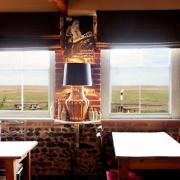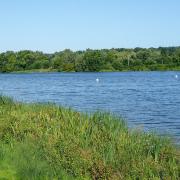The strange craters peppering the vast clearing are only the start of the extraordinary historical, geological and archaeological wonders of Grime’s Graves, near Thetford

As you emerge into the sunlight from the long, tree lined narrow lane, a single timber-clad building comes into sight, standing starkly alone in the centre of a remarkable, bare lunar-like landscape.
Yet this extraordinary site is as far removed from being a futuristic creation as you could imagine. Some 4,600 years ago it was a vast flint mine run on an industrial scale by the neolithic people who lived on the banks of the nearby rivers.
Grime's Graves, near Thetford, is one of Britain's most extraordinary historical sites yet it remains low-profile.
But explore the wildlife-rich landscape, visit the exhibition and head down one of the mines and you can't help but be in complete awe of the sheer ingenuity of the industry happening in that very spot, thousands of years ago.
From the geology of the land dating back millions of years to the evidence of early trade routes and engineering that was centuries ahead of its time, Grimes Graves offers a rare glimpse into an otherwise unimaginable past.
There are more than 400 mineshafts here, creating the craters and undulations which pepper the land.

Tim Lynch, historic properties steward for Grime's Graves, which is run by English Heritage, says: "The scale of what they were doing there was extraordinary. They would have been digging down through the chalk, just using antlers, to get to the sheet of pure tabular flint at the bottom."
He says when archaeologists studied the site in the past, they discovered an exposed layer of the pure flint, which could have led the settlers to begin mining.
"The walls of the wide shaft show that they passed through two layers of nodular flint set in the chalk - the type you see in ancient church walls and buildings - to get to the best quality material.
"Their buildings were straw and daub. They weren't building with flint; they wanted the purest type they could find and it would be removed in slabs. Nodular flint often has other things in it, like fossils, and when it was knapped, it could break up. But tabular flint was free of contaminates, which made it very easy to work and strong when used. It also had aesthetic value as the black flint could be polished to make a beautiful tool with ritual significance."
The flint would have been used to make tools, such as axes, arrows and blades, as well as scrapers, which were used to clean animal hides of tissue and membrane and also to create scythes for farming and clearing ground for settlements.

Tim says that evidence showed the flint was exported across the country from Scotland to the West Country, via nearby rivers and the coast.
"This was the workshop of the Neolithic times; they were providing flint for the whole country. It is really hard to understand the supply and demand of it all. How did they know that people in Scotland wanted this flint, or how much?
"Maybe it was traded from community to community, maybe some of the villagers went to a festival or market and it was sold there."
Tim says they have found evidence of ceremonial activities in and around the mines which showed the importance of rituals to the Neolithic people.
"Once finished with, the mine was filled with the chalk dug out from the next one. All the galleries running out from the bottom of the shaft would also be back packed with chalk as they were finished with as well.

"It meant they removed very little from the earth, returning what they didn't use - this would have been important to them as they wouldn't have wanted to have angered the gods. But it was also a very practical solution as well."
At the bottom of the main shafts were long, low galleries leading off underground and, says Tim, there is no evidence that any fire light was taken down in the mines to enable them to see.
"However, there is evidence that they built domes of white chalk in the centre of the bottom of the shaft," he says. "The light that flooded down would have reflected off the dome and into all the galleries.
"We also discovered that where the galleries turned away from the light source, holes, like little windows, had been cut into the rock, to enable some light to still get through. It was amazing engineering."
One of the mines, which is 7.2m deep, is always open to the public via a steep ladder. However, currently children have to be 10 and over to be allowed down.
"We are hoping to get a new ladder put in place this winter to enable children as young as seven to go down in the mines as we believe it is so important to engage with children at a young age and to tie in with what they are learning at school," says Tim.
"Ultimately though, we want families to come here and have a picnic and run around and up and down the dips, fly kites, look round the exhibition and hopefully learn a little more about this extraordinary place and leave excited and enthused about history."
Grime's Graves is open from Easter until the end of October. Car parking is free; full details of opening hours and admission charges can be found at english-heritage.org.uk
The Greenwell mine, which is 13m deep, is open on specific days for over 16s only and requires descent with a harness.
Stone me!
- Mining started 4,600 years ago and continued on the site for 350 years, before the advent of the Bronze Age
- There are 433 mineshafts across 96 acres
- It is believed 18,000 tonnes of flint was dug out
- Almost one million tonnes of chalk would have been moved to access it
- There were probably 100-150 people living near the site on the rivers Wissey and Little Ouse, which at that time were closer to the site
- As well as miners, they would have been farmers, hunters, boat builders and home makers
- Any Neolithic traveller or hunter would carry a pouch with flint and knapping tools with which to make blades or arrow heads, iron pyrites, a flint striker and tinder to start a fire



























